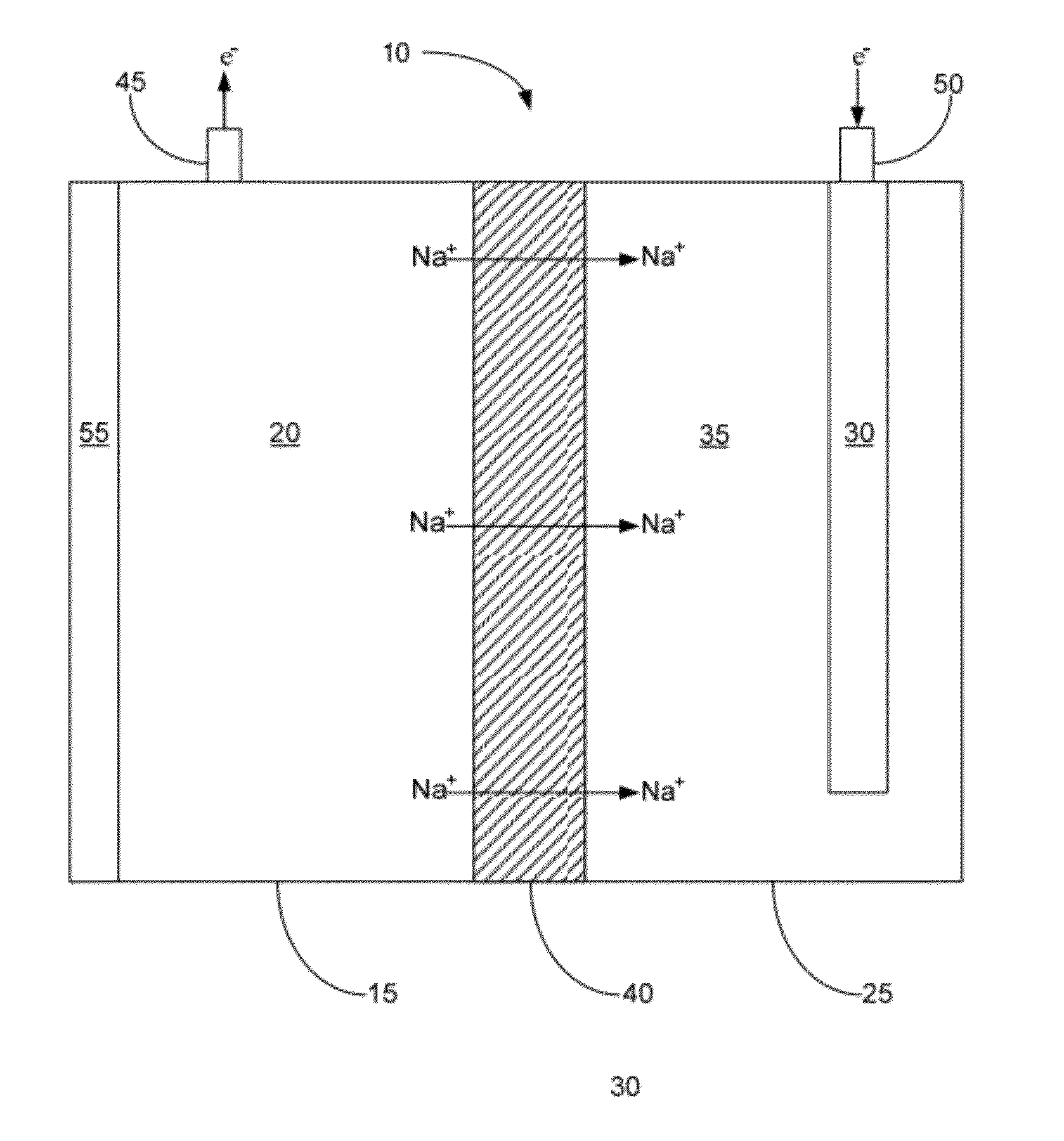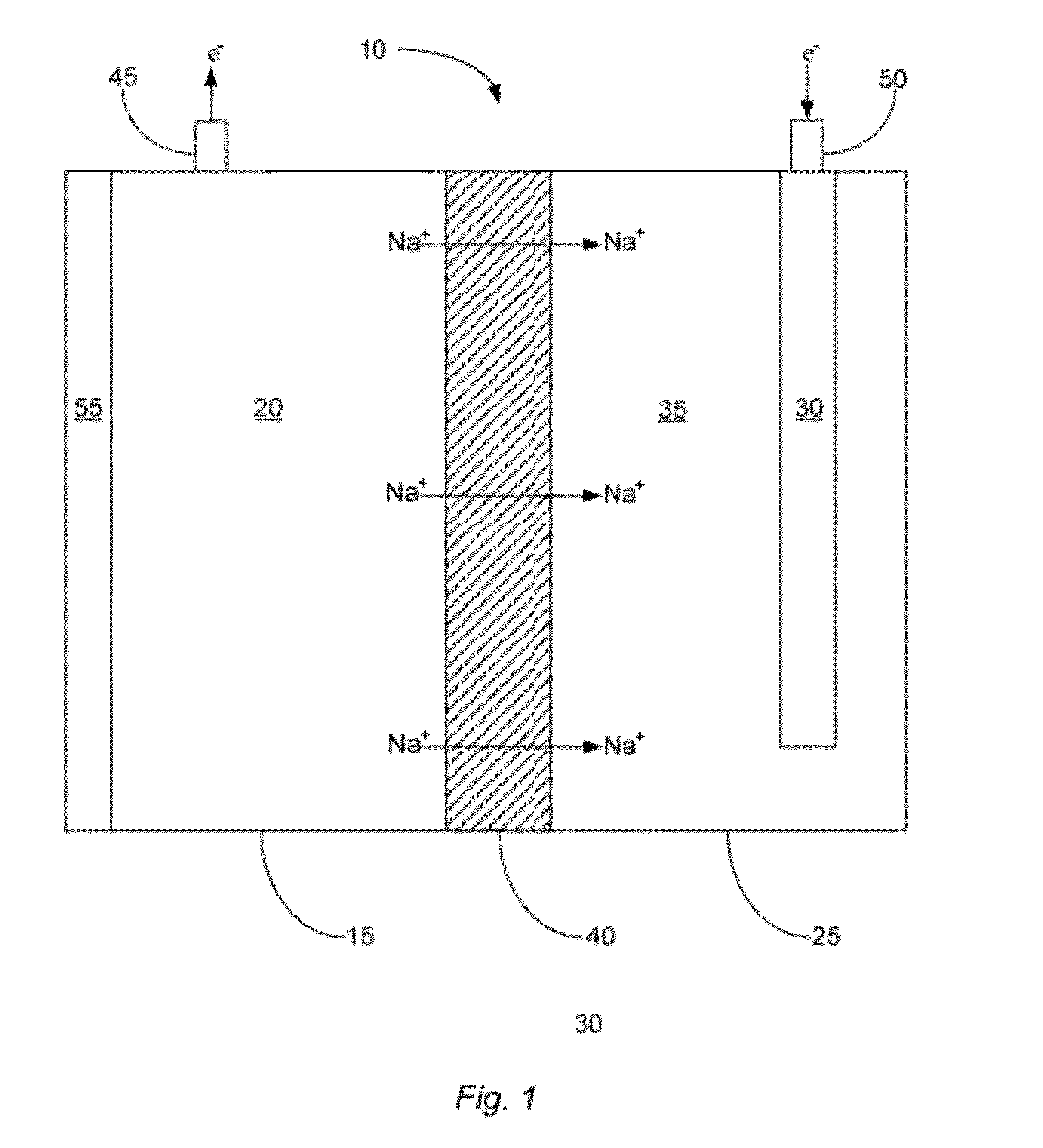Low temperature molten sodium secondary cell with sodium ion conductive electrolyte membrane
a sodium ion conductive electrolyte and secondary cell technology, applied in the field of batteries, can solve the problems of significant thermal management problems and thermal sealing issues, sodium-based rechargeable batteries may have difficulty discharging heat from batteries or maintaining the negative electrode and the positive electrode at relatively high operating temperatures
- Summary
- Abstract
- Description
- Claims
- Application Information
AI Technical Summary
Benefits of technology
Problems solved by technology
Method used
Image
Examples
example 1
[0050]In one example, an embodiment of the described cell 10 was prepared to contain a sodium negative electrode 20 and a positive electrode solution 35 comprising an aqueous solution that included sodium hydroxide at a concentration of about 50%, by weight. The cell was then heated so that the sodium negative electrode became molten. As the cell was operated at an operating temperature of about 120° C., the electrical potential (in volts) of the cell was measured for around 25 hours. The results of this test are illustrated in FIG. 3. Specifically, FIG. 3 shows that as the described cell operated, the cell was capable of providing up to almost 1.6V for a prolonged period of time. The open circuit voltage of this cell was measured to be 1.75V; however the positive electrode material used was not a NiOOH material, which is why the open circuit voltage was significantly lower than the theoretical voltage of 3.23V. The full capacity (in mAhr) was not recorded for this demonstration cel...
example 2
[0051]In another example, in order to show that a NaSICON-type electrolyte membrane is stable in the described cell 10 with a molten sodium negative electrode 20, an embodiment of the cell was prepared with a sodium negative electrode, a NaSICON-type membrane (namely membrane comprising Na3Zr2Si2PO12), and molten sodium. The cell was then operated for about 1650 hours at an operating temperature of about 112° C. and with a controlled current density of about 50 mA / cm2. Furthermore, during operation time, the NaSICON was cycled approximately 200 times. This demonstrates the feasibility of using NaSICON in the presence of molten sodium, something never before thought possible.
[0052]The experimental results from this second example are shown in FIGS. 4 and 5. Specifically, FIG. 4 illustrates the measured voltage of the experimental embodiment of the cell over the 1650 hours of operation time. In this regard, FIG. 4 shows that after the first 200 hours, or so, the interfacial resistance...
example 3
[0053]In this example, an embodiment of the described cell 10 was prepared to contain a sodium negative electrode 20 and a NiOOH positive electrode 30. A NaSICON membrane approximately 1 mm thick and having a diameter of about 1 inch separated the negative and positive electrode compartments. The positive electrode solution 35 comprised an aqueous solution that included borax at a concentration of about 30%, by weight. The cell was then heated so that the sodium negative electrode became molten. The cell was allowed to come to temperature for approximately one hour before being charged. The cell was charged at a constant 15 mA current. As the cell was operated at an operating temperature of about 120° C. and an external pressure of about 16 psi.
[0054]FIG. 6 shows the initial charging curve at 15 mA for four hours at 120° C. The cell was cycled under a variety of test procedures to gain a better understanding of how the NiOOH electrode performs at the elevated operating temperature b...
PUM
 Login to View More
Login to View More Abstract
Description
Claims
Application Information
 Login to View More
Login to View More - R&D
- Intellectual Property
- Life Sciences
- Materials
- Tech Scout
- Unparalleled Data Quality
- Higher Quality Content
- 60% Fewer Hallucinations
Browse by: Latest US Patents, China's latest patents, Technical Efficacy Thesaurus, Application Domain, Technology Topic, Popular Technical Reports.
© 2025 PatSnap. All rights reserved.Legal|Privacy policy|Modern Slavery Act Transparency Statement|Sitemap|About US| Contact US: help@patsnap.com



